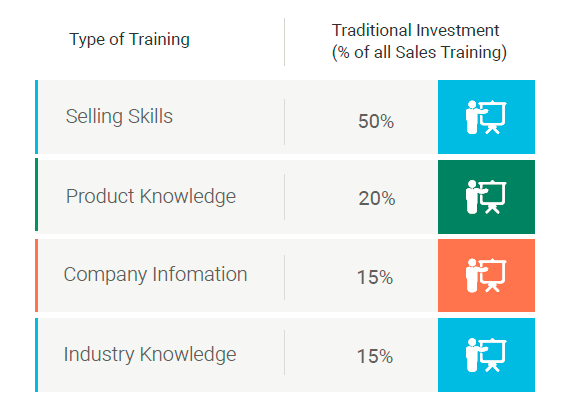I’ve got too much money and not enough places to spend it!
Chances are, if you are reading this article, these words have never come out of your mouth. With demand for training outreaching supply by a widening margin, this puts tremendous pressure on L&D teams to invest in the right solution. An entire book could be written on whether this money should be spent on leadership, customer support, onboarding, etc., so we have decided to only focus on one item in this article: sales training.
There are four main sales training categories that companies are investing in; Selling Skills, Product Knowledge, Company Information, and Industry Knowledge. While that is nothing surprising in itself the comparative investment in each category is shocking.

The Importance of Product Knowledge Training
The selling landscape has drastically changed in recent years. Customers are coming to the table much later in the traditional sales cycle and they are arriving armed with more data than before. Competition has also skyrocketed as of late, closing the differential gap between competitors.
Due to the increased competition and information availability, product knowledge training is more crucial than ever.
“But, doesn’t that mean I should spend less on product knowledge training
because my customers are already doing the research?”
Absolutely not; because your sales team needs to know even more about your product than the customer!
A successful sales person must know so much about the product that they can also point out differences in competing products, pointing out the specific differences that matter most to the customer. Instead of telling the customer all that your product has to offer, a successful sales person can outline the specific outcomes the customer stands to gain by using targeted case studies and references. Instead of becoming best friends with customers, sales people need to challenge the preconceived notions that customers have about products and present new applications that they have never thought about before.
The changes in buyer behavior and the impact this has had on sales training has been well-documented, in large part due to the work of Matthew Dixon and Brent Adamson, who co-wrote The Challenger Sale.
What Are the Symptoms of Poor Product Knowledge Training?
Sales Agents
- Significant push back from sales agents to consume training
- Sales Agents cannot align product features to customer pain points
- Sales Agents are slow to incorporate new product features or attributes into their sales pitch
- Average Order Value shrinks as cost, not value, becomes the primary discussion topic
Sales Management
- Onboarding new sales reps or channel partners takes several weeks
- Lack of visibility to the level of product knowledge from individual sales agents
- The sales cycle pushes beyond market standards
- Wide disparity in the performance of your sales agents and channel partners
Channel Partners
- Always the last to find out about new product features
- Unable to differentiate the product they are selling against competitors
- Difficult to find accurate product information
- Lack of brand affinity and loyalty
Double Down on Product Knowledge
Yes, companies are already investing heavily in product knowledge, as we outlined earlier, but not nearly at the rate in which they should. We recommend that companies invest 40% of their sales budget on product knowledge training and reduce the percentage they invest on selling skills from 50% to 30% to achieve increased results without spending more.
How Do You “Do” Product Knowledge Training?
Investing 40% of your sales training budget on “Sales Product/Service Knowledge” seems incomprehensible to most organizations because there are not nearly as many models for delivering this type of training as there are “Selling Skills”.
For this reason, we created the ARISE model, which aims to maximize the ROI of product knowledge training with a blended learning program that focuses on delivering information when, how, and where the sales team needs it the most.
This article is the first part of our White Paper “Investing Wisely”, for more on product knowledge training using the ARISE model read the rest!


































